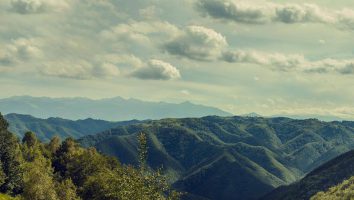At the „Cetăţuie” („Fortress” in english), the oldest of the Dacian fortifications of Orăştie Mountains, there are five obvious architectural sacred elements. It is the only citadel from Dacia on which the residence tower on the superior plateau are placed on the 23 degree axis N-E( the 23 degree axis represents the leaning of the earth regarding to the movement plan of the rotation around the sun), orientation which we can find only at the sanctuary of the citadel or to those from Sarmizegetusa Regia. Secondly, it is the only citadel where the towers were built after the proportion of golden ratio (φ=1,618). The third element of sacred architecture is built from the towers location on the plateau, at a bigger altitude than the four sanctuaries in the citadel. This situation is specific to all the Dacian citadels around Sarmizegetusa Regia. The fourth sacred architectural element is provided by the position of the „sacred precinct” of the citadel to the military zone. At Costeşti and also at the other citadels where sanctuaries had been found, these are located to S-E regarded to the main fortifications. The last element of sacred architecture and perhaps the most important is in the citadel’s location regarded to the direction in which the sun arises in winter solstice.

In the morning of 21st of December, from the Costeşti citadel the sun can be seen rising exactly above Sarmizegetusa Regia. In other words the sun is „saved” from falling in the area beneath the planetary ocean, by the mountain on which the future capital was built. The Dacians Sacred Mountain was being worshiped by the priest from the Costeşti citadel. Here, are found the oldest traces of habitation in the entire area. First the sun was born on the Sacred Mountain, located on the 23 degree E-S, and then saved winter by winter by the priests’ celebrations. In short time, the mountain that was stopping the sun from its ” falling” to South became sacred, receiving the name of Kogaionon.

Between the old Costeşti citadel and the Sacred Mountain, Kogaionon, as was known in time of Burebista Sarmizegetusa, there is a direct relation resulted from the positions occupied by both locations on the 30 degree E-S axis.
If the old tribal center would have been on another hill and not at Costeşti, Kogaionon would have been found on another position, but on the same axis regarding to the possible citadel. As a conclusion, the Sacred Mountain, Kogaionon, wouldn’t have existed on the Gradiştea Muncelului Hill without the presence of the Coştesti citadel on Fortress Hill.
From Cotiso, hotel in Transylvania, to the Costești citadel the trail takes only 20 minutes by foot, or 10 with a car with slight higher ground clearance.


